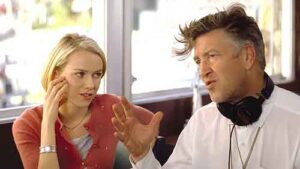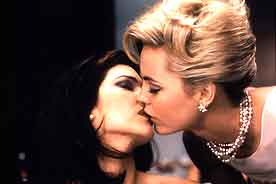One of the most unlikely cult classics of our time: a failed TV pilot reconfigured as a 2001 feature film from a writer-director who at the time was widely viewed as a burnout, and a leading lady whose Hollywood standing wasn’t much better. That writer-director was of course David Lynch, for whom MUHOLLAND DRIVE is now viewed as a signature film, and the actress Naomi Watts, best known in 2000 for appearing in CHILDREN OF THE CORN:URBAN HARVEST and TANK GIRL.
One of the most unlikely cult classics of our time: a failed TV pilot reconfigured as a 2001 feature film…
In its initial small screen form MULHOLLAND DRIVE marked Lynch’s inevitable break with ABC, who a decade earlier had shepherded the first two seasons of TWIN PEAKS. ABC executives apparently weren’t too happy with Lynch’s perfectionist ways on MULHOLLAND DRIVE, nor a dog shit close-up he insisted on filming.
The feature film expansion, entailing roughly an hour of French bankrolled extra footage, wasn’t exactly a hit, but it did win David Lynch the Best Director award at Cannes, and an Academy Award nomination in the same category. It also propelled Watts to superstardom (and a juicy role in TWIN PEAKS: THE RETURN), and boosted the careers of other, largely unknown cast members like Laura Elena Harring and Justin Theroux.
Functioning as both a love letter to Los Angeles, Lynch’s current place of residence, and a savage critique of same, MULHOLLAND DRIVE is to Lynch’s post-2000 oeuvre what BLUE VELVET was to the earlier portion. That is to say it’s his most characteristic and accessible recent work, with a retinue of obsessions—1950s pop culture, film noir tropes and a big city milieu (in place of the small town Americana of BLUE VELVET)—making themselves evident.
The fact that the film began as a TV pilot is evident in the many characters who are introduced and then abruptly dropped. They include Robert Forster as a quirky investigator, the film’s composer Angelo Badalamenti as a grumpy mobster (whose major acting moment consists of regurgitating a cappuccino into a napkin), Lynch’s producer pal Monty Montgomery as a mysterious cowboy who tells Theroux, playing a put-upon TV director, that if he “does good” he’ll see him once and if he “does bad” he’ll see him twice (as it happens, we see the Cowboy twice more, but Theroux only sees him once), and Patrick Fischler as a man who relates a dream he had in which he was terrified by a creepy individual behind a Hollywood diner.
The fact that the film began as a TV pilot is evident in the many characters who are introduced and then abruptly dropped.
Also featured are Mark Pellegrino as a remarkably inept hitman, a funny-sinister elderly couple, Billy Ray Cyrus (sporting his signature mullet) as a randy pool cleaner, the legendary dancer-actress Ann Miller as a tough building manager (her final role), a tiny blue box into which the characters have a tendency to disappear, a Hollywood nightclub called Silencio and a retinue of LA landmarks that include the iconic Pinks hot dog stand and the eponymous Mulholland Drive. Overshadowing it all is an astonishing performance by Watts as an aspiring actress named Betty, and Harring as a gorgeous amnesiac who calls herself Rita, who after surviving a car accident upends Watts’ life, and the overall film, quite spectacularly.
The relationship between these women, and the noirish narrative in which they become ensnared (also involved is a suitcase full of cash, a corpse and what is undoubtedly the hottest, yet also the most tender and emotional, sex scene Lynch has ever shot), makes for a hypnotically compelling and suspenseful two hours. Lynch’s storytelling gifts are well utilized here, even if the intended-for-television visuals aren’t as textured as we’ve come to expect (especially in the wake of LOST HIGHWAY and THE STRAIGHT STORY, undoubtedly two of Lynch’s most visually evocative films).
It’s not until the final 30 minutes that the obscurantism for which MULHOLLAND DRIVE has become known really comes into play.
It’s not until the final 30 minutes that the obscurantism for which MULHOLLAND DRIVE has become known really comes into play. In this portion scenes from earlier in the film are replayed with different cast members and characters assume entirely different guises (Lynch was admittedly under the spell of PERSONA), all in route to a profoundly bleak fade-out.
Some have claimed the key to understanding this film is in its later scenes, with the earlier ones being, supposedly, part of a vast dream and/or hallucination experienced by Watts (playing a jaded burnout named Diane who’s entirely different from the naïve Betty). The problem with this theory is that it fails to take into account the many viewpoint shifts and the vast cast. Puzzlement appears to have been the intended response; as Lynch has subsequently stated, “Getting lost is beautiful,” and you won’t find too many other films as confounding, provocative and—yes—beautiful as MULHOLLAND DRIVE.
…you won’t find too many other films as confounding, provocative and—yes—beautiful as MULHOLLAND DRIVE.
Vital Statistics
MULHOLLAND DRIVE
Universal Pictures
Director: David Lynch
Producers: Neal Edelstein, Tony Krantz, Michael Polaire, Alain Sarde, Mary Sweeney
Screenplay: David Lynch
Cinematography: Peter Deming
Editing: Mary Sweeney
Cast: Naomi Watts, Justin Theroux, Laura Elena Harring, Dan Birnbaum, Randall Wulff, Robert Forester, Brent Briscoe, Maya Bond, Patrick Fischler, Michael Cooke, Bonnie Aarons, Michael J. Anderson, Joseph Kearney, Enrique Buelna, Richard Mead, Melissa George, Mark Pellegrino, Sean Everett, Ann Miller, Dan Hedeya, Billy Ray Cyrus, Angelo Badalamenti, Monty Montgomery




